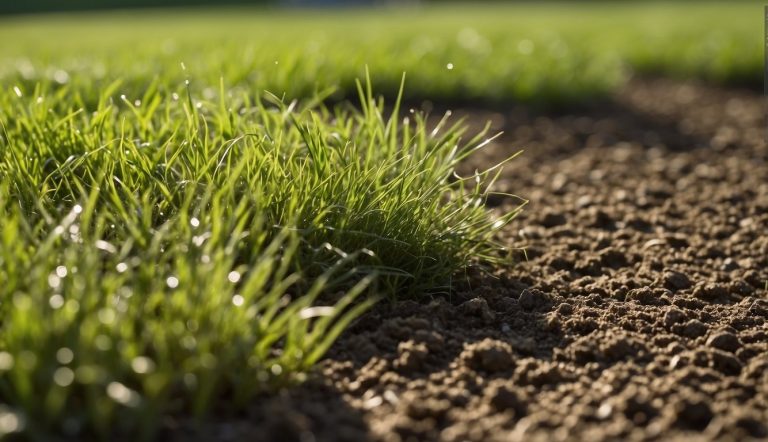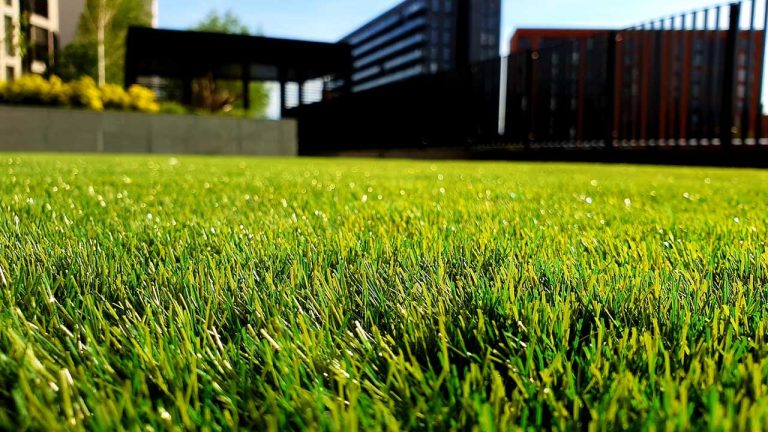Poorly Drained Lawn: Quick Solutions for a Healthier Yard
Maintaining a healthy lawn can be quite a challenge, especially when dealing with poor drainage.
I’ve discovered that poor drainage leads to waterlogging, where excess water is unable to escape the soil matrix, and this can spell trouble for the health of a lawn.
Standing water can suffocate grass roots, promote the growth of moss and fungi, and can even compromise the structural integrity of the surrounding property.

To ensure a lawn remains lush and vibrant, it’s crucial to address any signs of drainage issues promptly.
I’ve noticed that symptoms like pools of water after rain, squelchy patches underfoot, and the appearance of surface runoff can indicate an underlying problem with soil composition or landscape grading. Ignoring these signs can lead to a decline in the aesthetic and functional value of the property.
Key Points…
- Poor drainage can harm lawn health and property structure.
- Signs such as standing water indicate potential soil and landscape issues.
- Prompt intervention is needed to maintain a healthy lawn.
Table of Contents
Understanding Lawn Drainage Issues
When I look at a lawn, the presence of standing water or soggy patches signals drainage problems. It’s important for me to understand the issues at hand and their impact on the lawn’s health.
Identifying Poor Drainage
I first identify poor drainage by observing the lawn after a rainfall. Signs of excess water, such as standing water or areas that remain wet for several hours, indicate issues.
Additionally, if water flows across the landscape excessively, this overland flow points to inadequate drainage systems. By detecting these symptoms early, I can better address the underlying problems.
Effects of Waterlogging on Grass
Waterlogging affects grass in my lawn by depriving the roots of essential air. Excessive moisture suffocates the root system, hindering growth and leading to a decline in lawn health. Symptoms in the grass include:
- Yellowing or browning of blades
- Thinning turf density
- Increased vulnerability to diseases and pests
In poorly drained lawns, persistent waterlogging weakens grass, drastically reducing its resilience and aesthetic appeal.
Improving Soil and Landscape
When I’m tackling a poorly drained lawn, my focus is always on creating a thriving ecosystem that can handle water more effectively. By addressing soil compaction, enriching soil with organic matter, and selecting suitable plants, I can significantly enhance my landscape’s drainage and overall health.
Alleviating Soil Compaction
Compacted soil reduces its ability to absorb water, which is why I start by alleviating compaction. Here’s a method that works well for me:
- Aerate the Soil: Use a core aerator to remove small plugs of soil, allowing air, water, and nutrients to penetrate deeper. For best results, I aerate my lawn when the soil is moist but not saturated.
Amending Soil with Organic Matter
Amending soil can make a world of difference in drainage. Here’s how I do it:
- Incorporate Compost: I mix in well-aged compost to improve soil structure, which enhances its ability to retain moisture and nutrients while also allowing excess water to drain more efficiently.
Choosing the Right Grass and Plants
The right vegetation is crucial for improving drainage and reducing water retention on my lawn:
- Grass Types: I choose grass varieties known for deep root systems that can tolerate my local conditions. For example, tall fescue often works well in areas with drainage issues.
- Plants for Wet Areas: In spots where water collects more, I opt for water-loving plants like irises or native plants that are adapted to my local environment.
- Garden Layout: For my gardens, I consider raised beds or creating a slight incline to facilitate drainage, and plant moss in shady patches where grass struggles to grow.
Drainage Solutions for Lawns
Proper drainage is essential for a healthy lawn. I’ve explored various solutions and found that French drains and rain gardens not only manage water runoff efficiently but also add aesthetic value to the landscape.
Installing French Drains and Dry Wells
A French drain is a slightly sloped trench filled with gravel and a perforated pipe that diverts water away from the lawn. Here’s how I recommend setting it up:
- Dig a trench: Depth varies, but ensure a 1% slope for effective water flow.
- Lay the pipe: Use a perforated pipe to collect water over the length of the trench.
- Fill with gravel: Gravel allows water to flow into the pipe while filtering out debris.
- Add a top layer: Cover the gravel with soil or a filter fabric to prevent clogging.
A dry well works in tandem with a French drain or alone. It’s a large hole filled with gravel or a prefabricated tank that collects runoff and allows it to slowly soak away.
Creating Rain Gardens and Dry Creek Beds
Rain gardens serve as a natural catch basin, designed to be planted depressions. They not only manage water runoff but also support native plants and wildlife. To create a rain garden:
- Identify a location: Downgrade from your home but at least 10 feet away.
- Build the garden: It should be a mix of sand, soil, and compost for proper absorption.
- Choose plants: Native, water-tolerant plants work best for rain gardens.
Dry creek beds can be decorative and functional for lawn drainage. Resembling a natural creek, they guide excess water through the landscape with attractive river rock, curving naturally.
- Plan the path: It should lead water from high points to lower areas where water can be released safely.
- Excavate and line: Shallow excavation lined with landscape fabric to prevent weed growth.
- Place stones: Use various stone sizes for a more natural look.
In practicing these lawn drainage options, I make sure to comply with local regulations regarding water runoff and drainage systems.
Design and Maintenance Strategies
When dealing with a poorly drained lawn, I focus on two key aspects: effective landscape design and adhering to regular maintenance practices. These approaches help prevent issues such as erosion, weed overgrowth, and the challenges accompanying standing water.
Landscaping Considerations
For the initial design, I choose plants that thrive in wet conditions and avoid those that require a dry, drought-prone environment. It’s essential to incorporate features like slopes and drains to guide water away from the lawn, and I often suggest installing patios or walkways in areas prone to mud accumulation, as they reduce the grass area and improve drainage.
- Plant Selection: Choose water-tolerant species.
- Soil Composition: Amend soil to improve its drainage capabilities.
- Grading: Implement a gentle slope to encourage water flow away from critical areas.
- Hardscaping: Add patios and walkways to minimize lawn space and increase permeable surfaces.
Creating a new lawn in a poorly drained area necessitates a careful approach to grading and choosing the right grass that can handle moist conditions. Utilizing raised beds or berms can also mitigate the risk of ponding.
Regular Maintenance Practices
For upkeep, I mow the lawn at a height adequate to the specific grass type – not too short to stress it, and not too long to promote disease.
It’s important to note that frequent mowing can prevent thatch buildup, which can exacerbate poor drainage.
Regular aeration is also pivotal in assisting water absorption.
- Mowing: Keep grass at an optimal height respective to its type.
- Aeration: Conduct seasonal aeration to enhance soil drainage.
In times of anticipated heavy rainfall, I increase vigilance to stop potential mud problems before they start. Weed control is also more challenging in moist soils, so I’m proactive about pulling weeds and applying appropriate, environmentally friendly herbicides as necessary.
Managing Water Flow and Collection
To keep my lawn healthy and well-drained, I’ve learned that controlling water flow and collecting excess water are crucial. Here are some specific strategies I’ve employed to manage these issues effectively.
Utilizing Downspouts and Gutters
Downspouts and gutters are my first line of defense against water accumulation on my lawn.
I make sure that my gutters are clean and clear of debris, so they can efficiently channel water from rainfall away from my home’s foundation and lawn. I have also installed gutter guards to reduce the need for frequent cleaning.
The downspouts are directed away from my home to areas where water can be absorbed or further redirected. By doing this, I minimize the risk of water pooling around the foundations of my house which can lead to dampness and structural issues.
Creating Slopes and Channels
I have found that creating gentle slopes on my lawn ensures adequate drainage and guides excess water to designated areas, such as a garden or storm drain. Here’s how I approached this:
- Identify Low Spots: First, I observed where water collected in my yard after rainfall. These low spots are prime candidates for regrading.
- Grading the Lawn: I reshaped the lawn area by adding soil to low spots, creating a gradual slope away from my home and towards areas where water can be safely collected or dispersed.
- Channels and Drains: In addition to slopes, I’ve incorporated shallow channels that direct surface runoff towards the street’s storm drain systems or towards an on-property rain garden.
By addressing the slope of my lawn and strategically using gutters and downspouts, I’ve maximized flood control and minimized issues related to poor drainage.
Frequently Asked Questions

I understand that dealing with a poorly drained lawn can often be frustrating. Below, I’ve answered some common questions to help you address this issue effectively.
What are the typical signs that indicate my lawn has poor drainage?
If you’re seeing puddles long after it rains, or your grass feels spongy and waterlogged, these are clear indicators of poor drainage. Water that sits on the grass surface without proper absorption can also lead to discolored patches.
What are the most effective methods to fix waterlogged areas in a lawn?
Creating additional drainage pathways, such as a gravel or French drain, can effectively redirect water.
Aerating your lawn can also alleviate compaction, allowing water to seep deeper into the soil.
Can improving soil composition help with lawn drainage issues, particularly in clay soil?
Yes, adding organic matter like compost to clay soil can enhance its drainage capability. This amendment helps to create more space within the soil for water to percolate down away from the surface.
Who should I contact if I need professional help with my yard’s drainage problems?
Landscaping companies or drainage specialists are equipped to diagnose and correct lawn drainage issues. They can provide customized solutions for your specific lawn concerns.
What are the steps for installing a French drain to address lawn drainage?
1. Dig a trench from the waterlogged area to an outlet.
2. Lay a perforated pipe covered with fabric liner into the trench.
3. Fill the trench with gravel to facilitate water flow through the pipe.
How can I resolve the issue of low spots in my yard where water tends to accumulate?
Leveling the area with a mix of topsoil and sand can help prevent pooling. For persistent low spots, consider installing a catch basin or regrading the yard to improve surface runoff.







